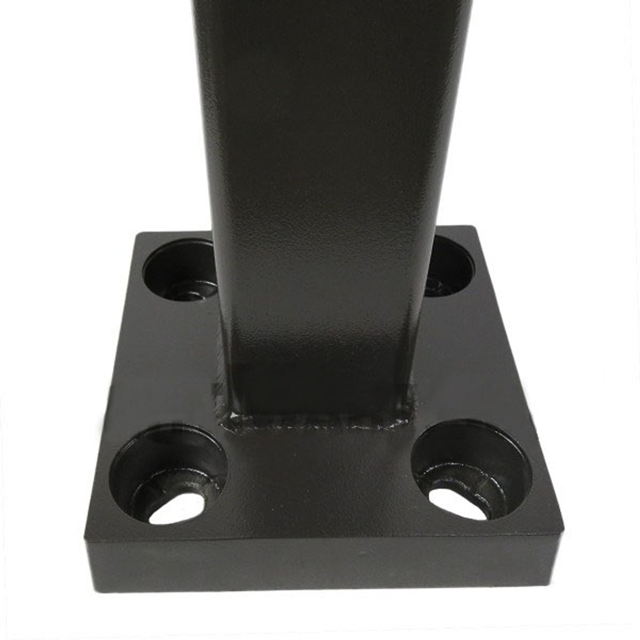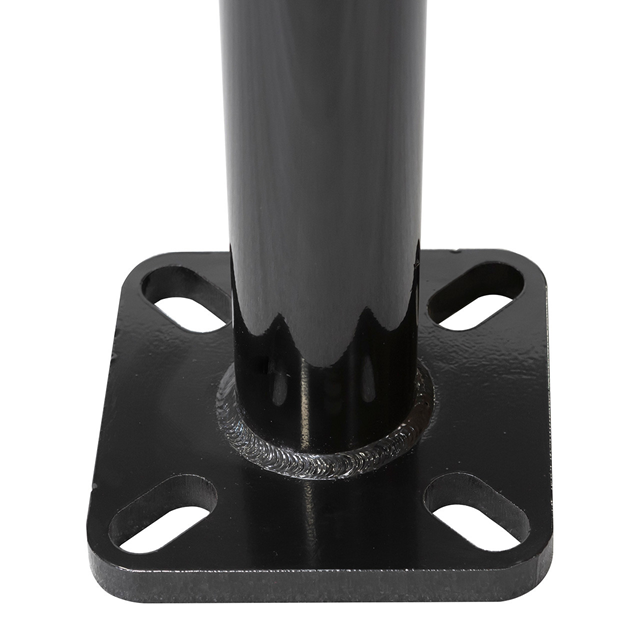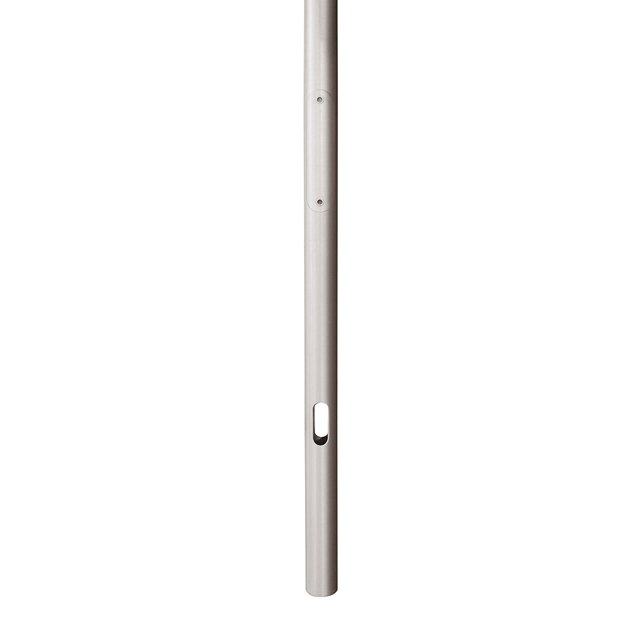In general, selecting the correct light pole for your outdoor lighting project requires a focus on functionality, aesthetics, and durability.
- You’ll need a light pole that is suitable for its application.
- You’ll need a light pole that blends into or accentuates its surroundings.
- You’ll need a light pole that is long-lasting and can withstand the environmental conditions of its location.
Aluminum light poles are an excellent option because they have a long lifespan (50+ years), are lightweight but strong, and are corrosion-resistant. Round aluminum light poles are an excellent choice, in particular. This article will highlight their advantages and give guidance on how to select the right one for your outdoor lighting project.
Round Light Poles versus Square Light Poles
Aluminum light poles are available in round or square shapes. You’ll want to opt for round poles, if possible. Here’s why:
- Round poles are more wind-resistant than square poles because square poles have flat sides. In the case of round poles, the wind can pass around the pole. This also makes round poles less prone to vibration.
- Another advantage that round poles have over square poles is their stress points at the base. High winds concentrate stress on the pole base at the four corners of a square pole whereas the stress at the base of a round pole is more evenly distributed.
Here is an example image of a square pole base:

Factors to Consider When Selecting Round Aluminum Light Poles
Height and Scale
An important consideration is the height of the light poles. Poles that are too short or too tall will have a measurable effect on lighting quality and public safety.
In general, the height of the pole impacts how far the light is dispersed. For smaller areas, like a small parking lot, light poles could be at the height of 20 feet. However, for bigger spaces that need more light coverage, like a highway, light poles may have to be 30-50 feet in height to adequately cover all areas.
Light source output is another factor to consider in pole height. For larger areas, fixtures emit higher amounts of light, so the pole should be taller. This will give uniform coverage of the area and reduce glare. Conversely, you will most likely use a fixture that emits lower light for smaller areas, so the pole height will be shorter. Also, if you mount a pole with a low light-emitting fixture too high, it will not light the area effectively.
Height Standards for Different Settings
- Streets: This will depend on the width of the street. 15- to 20-foot light poles will work for narrow residential streets, but you’ll need taller poles for wider streets. Wider roadways will require poles that are 25 to 50 feet tall with longer arms (4 to 8 feet in length) to get the light source closer to the center lanes.
- Parks: Lighting for parks is used to enhance aesthetics and safety. Shorter poles can be used to illuminate pathways whereas taller poles will be needed if there are large spaces like sports fields that are illuminated.
- Commercial Areas: Lighting for security and visibility requirements are the objective here. Because there can be a wide variety of area types, pole heights will depend on the function of the area. Shorter poles will be used to illuminate walkways and courtyards, while taller poles will be used to illuminate parking lots, loading docks, and general-purpose areas.
Diameter and Wall Thickness
To achieve optimal load ratings and rigidity under high wind conditions, light poles must strike a balance between shaft diameter, wall thickness, and height.
A light pole’s diameter is defined as the width of the pole at its base. It can be measured in inches by dividing the circumference by 2 times pi (Circumference / 2 x 3.14). The diameter of a pole affects its stiffness and wind resistance.
A light pole's wall thickness is another important consideration. Thicker pole walls will provide sheer strength whatever the pole’s diameter.
Taller poles will require a larger diameter and thicker walls to be structurally sound enough to handle wind and load conditions. For round aluminum light poles:
- Shorter poles (8-16 feet) will typically have a diameter of 4 inches and a wall thickness of 0.125 inches at a minimum. Stronger poles in this size range will have a diameter of 5 inches and a wall thickness of 0.188 inches.
- Taller poles (25-40 feet) will typically have a diameter of 6-7 inches and a wall thickness of 0.188 inches at a minimum. Stronger poles in this size range will have a diameter of 8-10 inches and a wall thickness of 0.250-0.312 inches.
For added wind resistance, round tapered light poles are recommended over round light poles. Round poles have the same diameter at the base and the top of the pole. Round tapered poles have the widest diameter at the base and the narrowest at the top. The narrower top of the tapered poles has less surface area for the wind to blow against.
More info: Using EPA Ratings to Determine a Pole’s Suitability for its Environment.
Installation Techniques
Aluminum light poles weigh much less than steel light poles which makes them easier to install. There are two main methods used to install light poles: anchor base and direct burial.
Anchor Base Installation
For this type of installation, the light pole is anchored to a concrete footing with anchor bolts, nuts, and washers.
Anchor base poles are more costly and time-consuming to install but they are easier to replace and can withstand impacts.
Here is an example image of an anchor base pole:

Direct Burial Installation
Direct burial light poles are inserted directly into the ground. There is no concrete base and anchor bolts are not required.
They are easier and cheaper to install, but the pole needs to be taller to account for the section that will be underground. Direct burial poles are not suitable for burial in loose sand or soil. Replacing them is more costly and time-consuming.
Steel light poles are not recommended for this type of installation. The section of the pole that would be below ground will be even more susceptible to rust and corrosion than the section above ground and its lifespan would be especially compromised. Aluminum light poles do not have this problem.
Here is an example image of a direct burial pole:

Environmental and Climatic Factors
Light poles installed in coastal areas require special considerations due to the environment. Seawater and hurricanes pose additional concerns that will drastically reduce their lifespan without additional layers of protection.
The salt in seawater is a major corrosion factor. Salt diffuses ions into water because it is an electrolyte. This intensifies the corrosion rate of metal. When combined with ocean air (which also contains salt), it causes steel to corrode 10 times faster than inland air with normal humidity.
Aluminum doesn't rust, but it does corrode. The oxide coating of aluminum is extremely resistant, and it will renew itself if it’s damaged. This keeps it relatively safe from corrosion. However, some factors can cause the coating to become unstable, exposing the metal.
During the manufacturing process, there are some coatings and treatments that can be applied to aluminum poles that extend their lifespan:
- Powder coating is a kind of finish where electrically charged particles are baked onto the pole at a high temperature. It is used to create a hard finish that is tougher and longer lasting than conventional paint.
- Anodizing is an electrolytic process that gives aluminum poles a protective oxide coating, creating a durable, corrosion-resistant surface.
An aluminum light pole can be both anodized and powder-coated for maximum protection.
More info: Strategies for enhancing durability through coatings or treatments.
Maintenance Tips and Longevity
Aluminum light poles have a longer lifespan than any other type of pole. However, they will require maintenance from time to time. Outdoor aluminum light poles will require regular inspections to check for signs of wear or damage from impacts, structural fatigue, or corrosion. Additional treatments can be applied as needed.
More info: Light Pole Maintenance Guide
LightMart Can Help
LightMart has a large selection of high-quality round aluminum anchor base light poles. This also applies to anchor base and direct burial round tapered aluminum light poles.
If you need your light poles quickly, we have a great selection of quick-ship light poles that are in stock and ready to ship.
Our friendly and knowledgeable staff has the know-how and expertise to help with your lighting project. Contact us today!
David DeWald is the E-Commerce Marketing Specialist at LightMart. He has been working in the industrial and commercial lighting industry since 2013 and is based in the greater Chicago area. David specializes in digital product management, web content writing, and product marketing. He regularly publishes lighting industry-related articles on the LightMart blog. You can visit his LinkedIn profile here.
